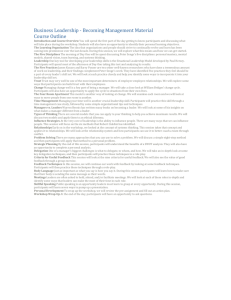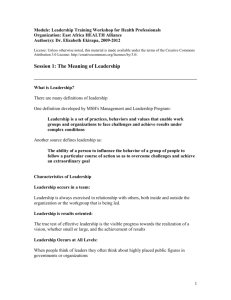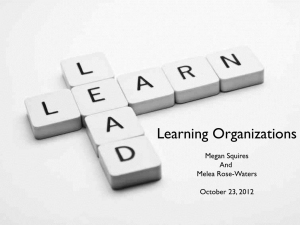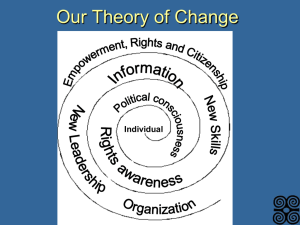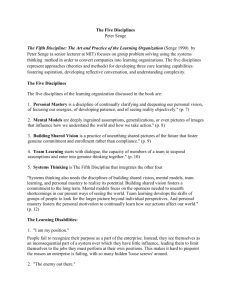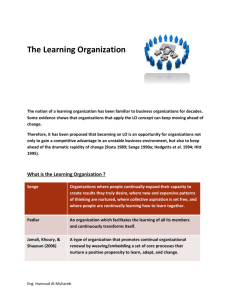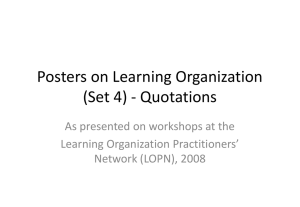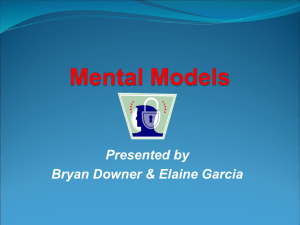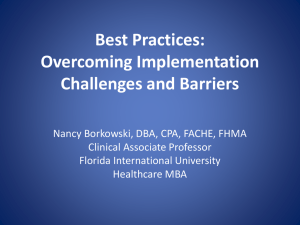IT IS ALL ABOUT CHANGE
advertisement
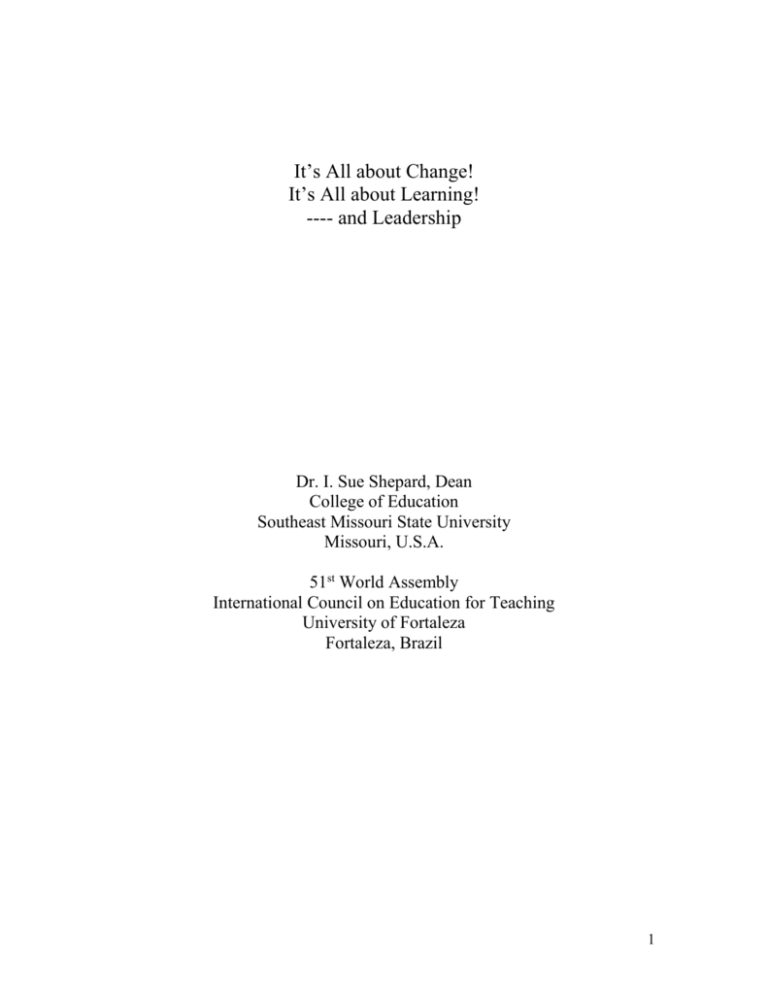
It’s All about Change! It’s All about Learning! ---- and Leadership Dr. I. Sue Shepard, Dean College of Education Southeast Missouri State University Missouri, U.S.A. 51st World Assembly International Council on Education for Teaching University of Fortaleza Fortaleza, Brazil 1 IT’S ALL ABOUT CHANGE! IT’S ALL ABOUT LEARNING! ---- AND LEADERSHIP Ah, change! We are all here for that reason! And as stated by Senge in The Fifth Discipline (1990) We both fear and seek change. Or as one seasoned organizational change consultant once put it, “People don’t resist change. They resist being changed.” (p. 155) Why are we here discussing the issues of local and global perspectives on change in teacher education? And at the same time, in the back of your minds, if we are honest, at least resisting change just a little bit? Because change is a constant and natural phenomenon, we are expected to deal with change in our own positions and at the same time guide and lead change in our organization and various educational settings. Therefore, this interest in change and the implementation of change requires an understanding of the “leadership of change.” I would like to speak briefly on issues of change and leadership in change as all of you are “leaders of change” or you would not be here. Then I will outline briefly the change that has been occurring over the past several years at Southeast as we have been addressing the issues of assessment and increased accountability as well as implementing many changes in technology. To provide leadership in change we must understand the many issues and challenges that face anyone who is involved with change both within themselves and in others when leading change. The following is a quote from Leading in a Culture of Change by Michael Fullan (2001) Change is a double-edged sword. Its relentless pace these days runs us off our feet. Yet when things are unsettled, we can find new ways to move ahead and to create breakthroughs not possible in stagnant societies. If you ask people to brainstorm words to describe change, they come up with a mixture of negative and positive terms. On the one side, fear, anxiety, loss, danger, panic; and on the other, exhilaration, risktaking, excitement, improvements, energizing. For better or for worse, change arouses emotions, and when emotion intensify, leadership is key. (p.1) The need for change is not only from our own concern for constant improvement but also to meet the external pressures for change. These pressures are those that come from the accreditation standards in the United States. Our national accrediting agency is the National Council for the Accreditation of Teacher Education (NCATE). In addition we have Specialty Professional Associations that have standards that must be met. Several of 2 these organizations are the National Association for the Education of Young Children (NAEYC), Association for Childhood Education International (ACEI), National Council of Teachers of Mathematics (NCTM), and the Educational Leadership Constituent Council (ELCC). Also, state or national departments of education have requirements along with the needed assessment and accountability to our own institutions. As those who are responsible for this change, we need to be knowledgeable of the research on change to better understand the processes and issues that arise. We need to be cognizant of the fact that what is happening is a natural occurrence. We need to know how to handle these concerns of others and ourselves. The research and knowledge are there to be used. A brief review of some of the research and knowledge will be mentioned but time does not permit an exhaustive discussion. Senge, in his writing on change, (as cited in Webber, 1999) has suggested that we have been still thinking of organizations as machines that can be fixed by driving change. “We keep bringing in the mechanics – when what we need are gardeners. We keep trying to drive change – when what we need to do is cultivate change” ( p. 184). Senge, et al. (1999) suggested ten challenges of change. He defined “challenges” as “opportunities to improve – by exercising our attention, understanding, and ultimate creativity. This is not dissimilar to the Chinese notions of crisis: two symbols meaning ‘danger’ and ‘opportunity’.” (Senge, et al., 1999, p. 29) These challenges were grouped into three categories. These three categories are: challenges of initiating change, challenges of sustaining momentum, and challenges of system wide redesign and rethinking. These challenges are discussed at length in the book (Senge, et al., 1999) titled The Dance of Change: The Challenges of Sustaining Momentum in Learning Organizations. The Challenges of Initiating: Not Enough Time – “We don’t have time for this stuff!” No Help (Coaching and Support) – “ We have no help!” “We don’t know what we’re doing!” Not Relevant – “ This stuff isn’t relevant!” Walking the Talk – “They’re not walking the talk!” The Challenges of Sustaining Fear and Anxiety – “This stuff is _________.” (Am I safe? Am I adequate? Can I trust others? Can I trust myself?) Assessment and Measurement – “This stuff isn’t working!” True Believers – “They don’t understand us!” /”We have the right way!” and Non-Believers – “I have no idea what these people are doing!”/”They are acting like a cult!” 3 The Challenges of Redesigning and Rethinking Governance – “They won’t give up the power!”/”Who’s in charge of this stuff!” Diffusion – “We keep reinventing the wheel!” Strategy and Purpose – “Where are we going? What are we here for?” Senge, et al.(1999) stated that these challenges are dynamic, nonlinear, and interdependent. Nor can the experiences of implementing change be easily extrapolated from situation to situation. He also emphasized that implementing change occurs through leadership at many levels within an organization. Two of the levels Senge discussed are local line leaders and internal networkers. Examples of the local line leaders within colleges and universities are faculty within a department where change is being implemented within the pedagogy of faculty and within the classroom. Internal networkers are faculty that work across departments and colleges, across the larger organization, to implement the change and build alliances. These internal networkers are key in helping Chairs and Deans “become aware of the support that change initiatives in the [organization] need form them.” ( Senge, et al., 1999, p. 17) Kotter (1998) presented a model for change that had eight steps. The eight steps were as follows with 2 or 3 needed requirements. Eight Steps to Transform Your Organization 1. Establish a sense of urgency Examine market and competitive realities Identify and discuss crises, potential crises, or major opportunities 2. Form a powerful guiding coalition Assemble a group with enough power to lead the change effort Encourage the group to work as a team 3. Create a vision Create a vision to help direct the change effort Develop strategies for achieving that vision 4. Communicate the Vision Use every vehicle possible to communicate the new vision and strategies to teach new behaviors by the example of the guiding coalition 5. Empower others to act on the vision Get rid of obstacles to change Change systems or structures that seriously undermine the vision Encourage risk taking and nontraditional ideas, activities, and actions 6. Plan for and create short-term wins Plan for visible performance improvements Creating those improvements 4 Recognize and reward employees involved in the improvements 7. Consolidate improvements and produce still more change Use increased credibility to change systems, structures, and policies that don’t fit the vision Hire, promote, and develop employees who can implement the vision Reinvigorate the process with new projects, themes, and change agents 8. Institutionalize new approaches Articulate the connections between the new behaviors and organizational success Develop the means to ensure leadership development and succession Kotter (1998) stated that the successful change process goes through all of these steps and requires substantial time. In addition, any difficulties in the process can slow the change that occurs. Both Senge, et al. (1999) and Kotter (1998) have provided “labels” and “terminology” that can assist us in recognizing what is needed or occurring as we as leaders attempt to lead change. For change to succeed, the seven “propositions for success” (Fullan & Miles, 1992, p. 749) must be utilized as a whole. These seven propositions are: all change is learning and becoming good at something new; change can not be planned in detail but requires continuous planning; change has problems that must be coped with; change needs the resources of time, money, energy, capacity building, and pshcyo-social resources; change needs to have people across all levels who are empowered to manage and supported by upper levels of leadership; change impacts the total system and the culture of the system; and all change is implemented by those on the front lines, those individuals who Senge calls local-line leaders. Living out the seven propositions for successful change means not only making the change process more explicit within our own minds and actions, but also contributing to the knowledge of change on the part of those with whom we interact. Being knowledgeable about the change process may be both the best defense and the best offence we have in achieving substantial reform. (Miles & Fullan, 1992, p. 752) I am not certain that we are utilizing what is known about the process of change as we proceed in improving our preparation programs for pre-service teachers. If we do not use this knowledge, it is doubtful if we will be successful. Everyone that is involved with the implementation of change needs to know how to bring about change as well as what factors hinder change. This includes faculty, chairs, deans, and provosts 5 Senge, et al. (1999) suggested “ten challenges of change.” Kotter (1998) presented an eight step model for successful change. Fullan and Miles (1992) provided “seven propositions for success” (p. 749). Schein (1992) has suggested an additional way to understand the change process. Schein presented the change process as having three steps. The three steps were unfreezing, cognitive restructuring, and refreezing. These three steps can be made parallel to the processes presented by Kotter (1998), Senge, et al. (1999), and Fullan and Miles(1992). A comparison of these models should provide a basis for understanding how to approach change. (See Table 1) Table 1: Implementing the Change Process: Comparison of Models Schein (1992)Steps of Change 1.Unfreezing 2.Cognitive restructuring Kotter (1998)- 8 Steps to Transform Organization 1. Establish a sense of urgency 2. Form a powerful and guiding coalition Senge, et al. (1999) –Challenges of Change 1. Initiating 3. Create a vision b. No help c. Not relevant d. Walking the talk 2. Sustaining 4. Communicate the vision 5. Empower others to act on the vision 6. Plan for an create short term wins 3. Refreezing 7. Consolidate improvements & produce more change 8. Institutionalize new approaches a. Not enough time a.Fear & anxiety b. Assessment & measurement c. True believers & non-believers 3. Redesigning and Rethinking a. Governance b. Diffusion Fullan & Miles (1992) - 7 Propositions for Success 1. Learning and becoming good at something new 2. Can not be planned in detail but requires continuous planning 3. Problems that must be coped with 4. Needs resources of time, money, energy, capacity building, and psycho-social resources 5. People at all levels empowered to manage & supported by upper-level leadership 6. Change impacts the total system & culture of the system 7. Implemented by front-line leaders c. Strategy & purpose 6 Using Schein’s (1992) term of “unfreezing” and looking at the 8 Steps to Transform Organizations of Kotter (1998), you see terms used that would cause change of thought or unfreezing: establish a sense of urgency, form a powerful and guiding coalition, create a vision. The same is true with the Senge (1999) and Fullan and Miles (1992) models. When comparing “cognitive restructuring” (Schein, 1992) with communication of the vision (Kotter, 1998), cognitive restructuring would result from communication of the vision or ongoing support and sustaining the change (Senge, 1999) and addressing problems that must be coped with (Fullan & Miles, 1992). “Refreezing” (Schein, 1992) occurs when improvements are consolidated and institutionalized (Kotter, 1998) redesigning and diffusion occurs (Senge, 1999), and individuals at all levels within the organization from upper-level leadership to front-line leaders support and implement change (Fullan & Miles, (1992). A key factor in the success or failure of change within the organization is the support of upper level leadership and the knowledge that the leadership has of the change process. All attempts are not successful!! Fullan and Miles (1992) also presented seven reasons why reform fails. The reasons for failure as stated by Fullan and Miles were: not understanding the change process, not understanding the complexity of the problems that are being addressed, accepting symbolic change rather than substantive change, adopting “quick fixes” or “fads,” misunderstanding the real reasons for resistance, not providing sustaining support for innovations, and not acknowledging the systemic aspects of change. Sirkin, Keenan, and Jackson (2005) stated that we who are involved with change have been putting too much emphasis on the “soft issues, such as culture, leadership, and motivation” (p. 110). These authors state that we must also be addressing the hard factors that include determining how much change has been achieved, communication of the importance of the changes both internal and external to the organization, and the ability to initiate change quickly. Other hard factors are the time needed to implement the change, the amount of resources needed and results that are desired. Before I review with you briefly what change has been happening at Southeast in our efforts to implement processes and structures for assessment and accountability, I recommend to each of you, at whatever level of leadership you may be, to read a book that I have referred too several times in my comments – Leadership in a Culture of Change by Michael Fullan (2001) and published by Josey-Bass. Fullan (2001) presents and discusses in a very readable format a model, or as he calls it, “A Framework for Leadership” (p. 4). He suggests 5 components of leadership required for successful change: (1) moral purpose, (2) understanding change, (3) relationship building, (4) knowledge creation and sharing, and (5) coherence making. These 5 components are surrounded by energy, enthusiasm, and hope. With the commitment of 7 members both internal and external to the organization, results will occur where more good things happen; fewer bad things happen. Note the second component, understanding change. This is crucial to successful implementation of change. This is what all the gurus of change have been studying as I have presented in this brief discussion, both the soft and hard issues. Let’s look at what change has occurred at Southeast in accountability and assessment: University requires a yearly assessment report that was by department and now by program with a required structure that is evaluated by a University assessment committee. This has been in process for seven years with many revisions. NCATE requires data and information for accreditation with an assessment model required as of November of 2001. This change occurred just before our accreditation visit in the spring of 2002. Then in 2004, a new format for the NCATE review process was piloted and now implemented fully. The Specialty Professional Associations (SPA) determine six kinds of assessment data that are to be used and we must have at least two years of data for submission in the spring of 2008. Missouri Department of Elementary and Secondary Education requires a MoSTEP portfolio of all graduates that demonstrates competencies. Southeast was one of The Renaissance Group members that were part of a Title II Teacher Quality Grant funded by the U.S. Department of Education that began in 1999 that developed the Teacher Work Sample (TWS) Portfolio.The TWS, with the assistance of consultants from a technology firm, FolioTeK, went from a paper-&-pencil document to an electronic format. The TWS portfolio was approved for use by the state Department of Elementary and Secondary Education (DESE) by Southeast in place of the MoSTEP portfolio for all pre-service teachers. This created many issues in the transition from one format to the new format. The electronic TWS portfolio has undergone continuous modification and revision to make it more user and faculty friendly. We are in the process of remodeling many rooms in our building and installing new technology. To support faculty and provide professional development, faculty have been reassigned and additional training will be provided. Have we seen the issues and aspects of change as discussed by Fullan, (2001); Fullan and Miles (1992); Kotter (1998); Schien (1992), Senge, et al. (1999); Sirkin, Keenan, and Jackson (2005). Yes, every one of them!! Several time over! Does having this awareness of how change occurs and the challenges that must be faced? My answer is “Yes!”It may not make change any easier but it will make the challenges of change more tolerable. Because you know that other organizations that have implemented change have faced these same issues. 8 REFERENCES Fullan, M.G. (2001). Leading in a culture of change. San Francisco: Josey-Bass. Fullan, M. G. & Miles, M. B. (1992). Getting reform right: What works and what doesn’t. Phi Delta Kappan, 73(10), 745-752. Kotter, J.P. Winning at Change. Leader to Leader. 10 (Fall, 1998): 27-33. http://www.pfpd.org/leaderbooks/121/fall89/kotter.html Schein, E. H. (1992). Organizational Culture and Leadership. 2nd Edition. San Francisco: Josey-Bass. Senge, P. (1990). The fifth discipline. New York: Currency Doubleday. Senge, P., Kleiner, A., Roberts, C., Ross, R., Roth, G., & Smith, B. (1999). The dance of change: The challenges of sustaining momentum in learning organizations. New York: Doubleday. Sirkin, H.L., Keenan, P., & Jackson, A. (2005). The hard side of change management. Harvard Business Review, 83(10), 108-118. 9
